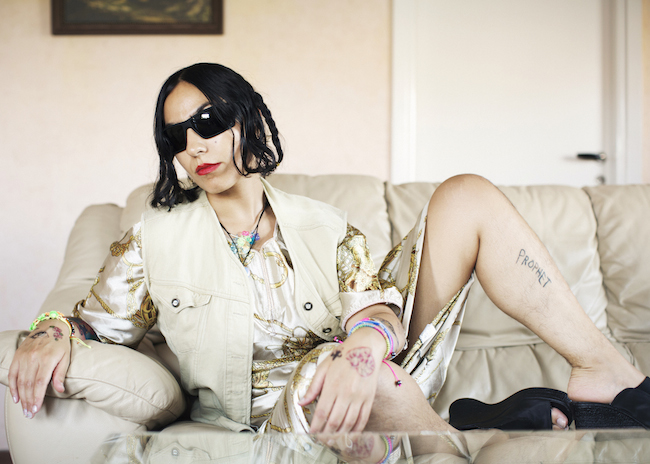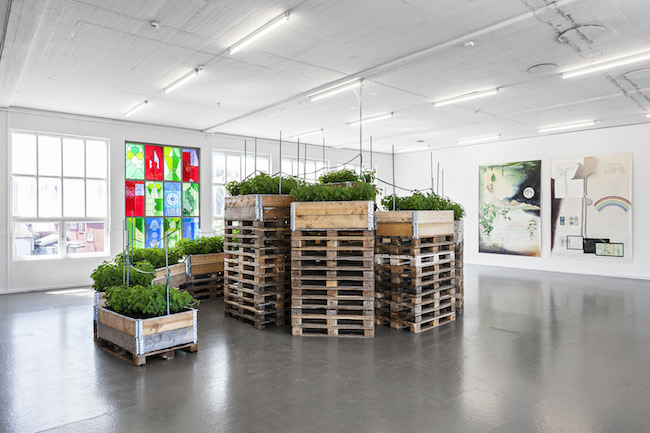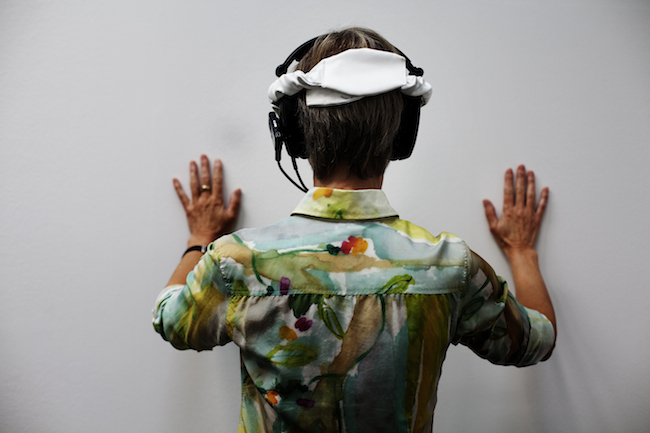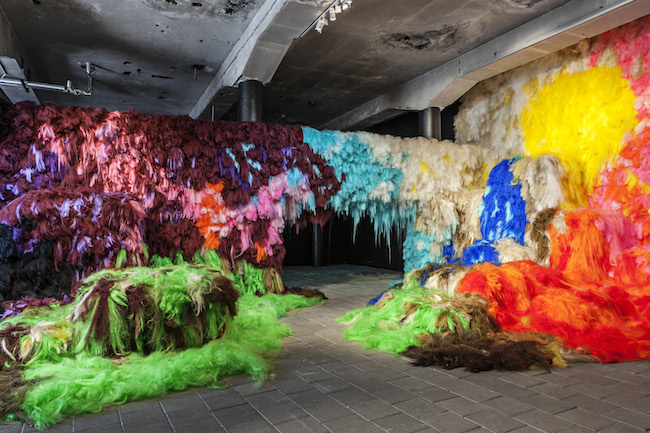
Don’t Fall In With the Wrong Crowd
Momentum 8, a Hyper-Contemporary Intellectual Playground
Anna Mikaela Ekstrand
06/07/2015
A team of four curators, all relatively young and definitely reputable, curated the 8th edition of Monumenta - Jonatan Habib Engqvist (SE), Birta Gudjonsdottir (IS), Stefanie Hessler (DE/SE), Toke Lykkeberg (DK). This time the biennale is being held in Moss, Norway, the picturesque former home of the tormented artist Edvard Munch. “The exhibition itself and the selection of the curators shows that the true strength of the North is a braveness to open up and work internationally,” as one German visitor eloquently commented.

Zhala, 2015. Copyright for artwork: Zhala. Photo: Märta Thisner
The biennale reflects international curatorial trends and showcases work by artists – from both the Nordic countries and further afield – that pertains to contemporary society and culture, all tightly curated within the over-arching concept of Tunnel Vision. Swedish artist Zhala, a founding member of the LGBT club ‘Donna Scam’, has created a soundtrack for the biennale – her ‘religious rave’ (or so-called ‘cosmic pop’) is on loop in two exhibition venues in which visitors are met with a cacophony of audio, visual and tactile experiences. Zhala performed during the opening. Issued in part to cover the increasingly important concept of ‘branding’, as well as to ensure that all the senses are engaged, a custom scent has been commissioned by the Norwegian scientist and artist Sissel Tolaas. The scent fills both main exhibition spaces, and visitors are encouraged to even touch the walls – which leave a lingering scent on your fingertips. Subsequently, entering the main exhibition space through the wall of fog created by Japanese artist Fujiko Nakaya – in addition to the strong scent and music – is a truly impressionable experience. “Tunnel Vision shows you how you are caught in your own tunnel vision, how you can be led to other visions, and that parallel tunnels exit into the world,” a guest commented during the opening.
Read in Archive: An interview with Momentum co-curator Stefanie Hessler
The works on view complement each other by creating a sense of communality or an alternate world; they explore phenomena relevant to our fast-paced, hyper-connected society: games, surveillance, group dynamics, psychology and the ego, among other things.

Steina (Steina Vasulka). Machine Vision, 1978. Photo: Vegard Kleven © Punkt Ø/ Momentum
The concept of ‘a room of one’s own’ (from Virginia Woolf’s prolific extended essay of the same name) is presented as an important premise for artistic practice. The seminal feminist text was first published in 1929 and was based on a series of lectures delivered at two women’s colleges at Cambridge University. Shedding light on patriarchy in the literary tradition, Woolf addresses the limitations that female authors of the past and present have faced; it also argues that for an artist to create, the artist must have a room of one's own and the economic means with which to support themselves. Many other themes are brought up in the essay, such as female homosexuality. For example, Woolf was accompanied by her lover, Vita Sackville-West, while teaching at the college, thus setting a practical example for students and peers on the topic of “lesbianism”…but this is not the time to gush over Woolf’s exceptional career or persona. Moving back to the topic at hand, it was a stroke of genius that the curators chose the concept of ‘a room of one’s own’ as a pillar in their theoretical framework for the biennale. The reasons for this genius being that, firstly, Scandinavia is in the forefront for gender equality, and secondly, that the Nordic countries are all modern welfare states whose citizens have been relieved of the boundaries of the class system. For artists, there are many possibilities for state funding and grants with which to sustain their artistic practice. Not to mention the interdisciplinary aspect of using this specific phrase! ‘A room of one’s own’ clearly deals with these themes and questions without overpowering the over-arching concept of Tunnel Vision. While powering through the old factory building and Galleri F15, which is where Momentum takes place, I urge you to think of Virginia Woolf and the premises necessary for being an artist, and what factors and structures might facilitate artistic production – doing so will add an interesting dimension to the experience.

Joanna Lombard. Orbital Re-enactments. All Rights: Joanna Lombard
The work of Berlin-based artist Brody Condon often deals with the aftermath of trauma and the over-identification of fantasy in contemporary culture. “Future Gestalt”, Condon's video on view at Momentum, is no exception; it features Live Action Role Playing in which participants partake in a live therapy session by acting out deeply rooted emotions – all set in a semi-fictional world. The particular LARPers who were selected specially for the biennale made an unexpected appearance at the opening party, and the heightened tension in the room was palpable. Those of you who have recently visited Paris might have seen or heard about “Air de Jeu” at Centre Pompidou, an exhibition bringing work by the likes of Amalia Pica, Christian Falsnaes and Pilvi Takala together within the context of contemporary art and games. In a sense, games control people’s behavior but, at the same time, they create communality. Lundahl & Seiti’s site-specific piece, “Symphony of a Missing Room”, also deals with vulnerability in a game-like setting: in their minds, users enter into a new world after putting on the provided headphones and goggles. Joanna Lombard’s sound installation, installed outside of Galleri 15, surrounds the visitor with condescending laughter, as if to say we are all looking and laughing at you.

Christine Ödlund. Tower of Eukaryote, 2015. Photo: Vegard Kleven © Punkt Ø/ Momentum.
The New York-based Icelandic artist Shoplifter has designed an entire room in which you can lose yourself in artificial hair. An overwhelming, post-pop video work by L.A.-based American artist Ryan Trecartin (the poster boy for subversive art of the digital age) has also been curated into the exhibition. In stark contrast to such things as new media, internet-based work and consumer culture is Christine Ödlund’s “Tower of Eukaryote”, which consists of nettles, larvae and cocoons. As the piece has been created with organic material and organisms, it will change over time; the concept of larvae turning into butterflies in an exhibition space is magical.

Lundahl & Seitl. Symphony of a Missing Room (Kunstmuseum Bern), 2014. Copyright and / or courtesy for the artwork: Lundahl & Seitl. Copyright for the picture: Loulou d'Aki
The biennale reaches far beyond the city of Moss, as illustrated by Edward Shenk’s “Momentum Trailer” which has been uploaded on YouTube. The artist draws connections between the Svalbard Global Seed Vault, Norwegian oil companies, and the biennial itself – in a video stylized to resemble the language of right-wing conspiracy theories. An app has also been commissioned, created by Valia Fetisov, Dzina Zhuk and Nicolay Spesivtsev. It’s called “Paranoid App” – get it in your app store of choice!

Hrafnhildur Arnardottir (A.K.A. Shoplifter). Nervescape IV, 2015. Courtesy of the artist. Photo: Vegard Kleven © Punkt Ø/ Momentum
Momentum 8 – set in the wealthiest of the Nordic countries where the quality of life is amongst the highest in the world – is an eerie, fun and egocentric exploration of our Western consumerist contemporary society in which each individual is the center of their own universe; it is well worth a visit. The sensation that we live in a society that caters to individual needs and experiences is ever present. As the press release boldly states: “If the Internet has been a window to the world, it is now also our own mirror image on the screen.”
I urge you to accept this opportunity of an assisted foray into your own mind.
Momentum 8 is open through September 27th, 2015, in Moss, Norway.